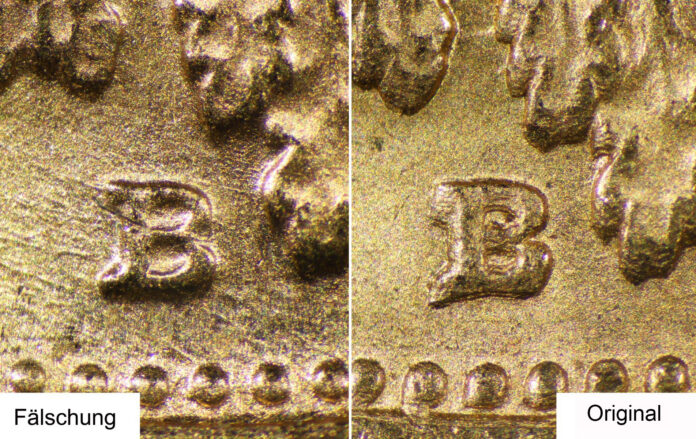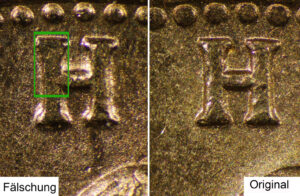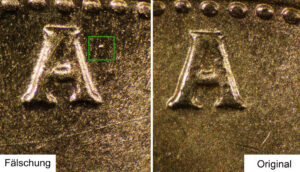When my last article was published, I received many questions on counterfeits of the most widely traded coins. Being formulated in different ways, the core of these questions was always the same: how can I check whether the bars and coins I bought are authentic? Astonishingly enough, only a single person asked how one could be sure of an item’s authenticity prior to the purchase in order to avoid buying a fake coin!
To make things a little easier, I photographed and described some typical counterfeits. I chose pieces that I bought at the end of the 90s, but which can still be found in various coin shops and private collections today. The information provided has the mere purpose of raising awareness and not that of coming to a final judgement on the authenticity of your pieces.
Today we begin with CHF 20 Vreneli coins, in the next parts I will discuss Austrian ducats, English sovereigns and, finally, USD 20 coins.
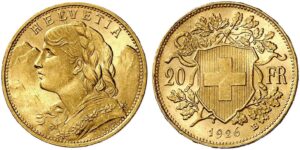
The Popular CHF 20 Vreneli
CHF 20 Vreneli coins with a mintage of more than 58 million pieces are part of the best known European group of coins.
The obverse features the head of a woman, looking to the left. Her hair is tied into a braid, her dress embroidered with an edelweiss motif. In the background, you can see mountains. At the top there is the inscription “HELVETIA”, at the bottom right the name of the artist (“F. LANDRY”). Around the rim is a border of dots. The reverse shows the face value “20 FR”, numbers and letters are separated from the Swiss coat of arms by an oak branch. At the bottom is the year, the mint mark “B” at the right. Here, too, you find a border of dots around the rim. The edge inscription consists of 22 raised stars (7/7/8, a total of 22, one for each canton). The coins issued after the war have an “L” next to the year (1935) to distinguish them from coins actually minted in 1935. Instead of the stars, issues with the years 1947 and 1949 feature the edge inscription: “<6 stars> AD / LEGEM ANNI / MCMXXXI <1 star>”.
The Vreneli: Popular Among Dealers, Investors, Counterfeiters
These coins are part of the portfolio of every gold dealer. Individual coins are traded just as often as consignments of 1000 or 2000 pieces.
Almost all mintage years of Vreneli coins are being sold a few percent above spot price.
The two exceptions are:
- Gondo coins. In 1897, a small amount of 29 gold Vreneli coins were minted from gold mined at Gondo. These issues can be recognised by their lighter colour – their alloy contains silver, that of a normal Vreneli does not – and by a cross-shaped countermark on the Swiss cross.
- coins minted in 1926. The mintage of these issues was smaller than usual (50,000 pieces).
The alloy a Vreneli is made from consists of 900 parts of pure gold and 100 parts of copper. This is the reason for the slightly reddish colour of these coins.
The parameters: a fineness of 5.8g, a diameter of 21mm and a thickness of 1.25mm. These figures are not unusual for gold coins, however, only 20 francs Vreneli coins have gained such popularity. These small gold coins enable small investors to invest in gold without paying a large amount of money and make it possible for dealers and coin owners to determine exactly how much of their capital was re-allocated.
The characteristics described above have helped this small Swiss coin become a favourite of all those who are active on the gold market: customers, dealers, collectors – and, unfortunately, counterfeiters.
Together with dollar and reichsmark coins, the Vreneli is among the most frequently counterfeited coins I have seen in my 35 years of work. However, even in the field of counterfeit coins, Vreneli coins are something special. I know many varieties of forgeries featuring different mintage years. However, it is not true that certain years are preferred by counterfeiters (as it is the case regarding the 1904 20 US$ Liberty) or that there are forgeries of almost every mintage year (as it is the case regarding the 20 RM pieces of William II of Prussia).
Moreover, it is astonishing that issues with the year 1935 are not that often counterfeited. To put it diplomatically, the quality of the official 1935 LB restrikes is – due to the huge quantity of coins minted (over 20 million pieces) – partly very blurry. This makes a forger’s task much easier. Here we are dealing with the rare case that the quality of some counterfeits is better than that of the original.
Many of the counterfeits I know are made from gold with a fineness of just slightly less than 900, or are even made from the exact same alloy as the original coin. This makes identifying counterfeits difficult when testing devices are used that carry out an analysis based on electrical conductivity. In such cases, the devices indicate the correct figure, which should be somewhere between 9.1 and 8.45 MS/m.
A Specific Counterfeit: 20 Francs 1922 B
As a specific example, I want to show you the 20 francs piece from 1922 B. This forgery is an interesting variety for the following reasons: As far as I know, four different counterfeit versions exist of the 1922 piece and each of them was made with a different die. The quality of the forgeries varies from very good to average.
I leave it to the reader to judge the quality of the counterfeit presented here. The coin weighs 6.52 grams, has a horizontal diameter of 21.06mm and is 1.12mm thick.
Its electrical conductivity is 9.4 Ms/m – at 120 KHz; measured with a Sigmascope C.
The composition of the alloy is: 88.6% Au; 0.83% Ag; 10.3% Cu and 0.04% Zn; measured with the XRAY XAN 220.
The forgery was created using minting techniques.
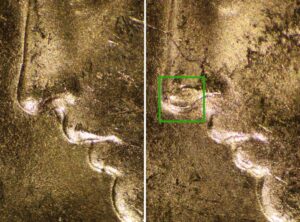
The obverse is relatively well made. However, a close look at the tip of the nose reveals an imperfection (negative).
The minting quality of the letters H and A differs from the original coin. Next to the A you can see a small dot (positive).

As you can see on the reverse, the year, which is not sharply minted, attracts attention. The shape of the numbers is similar to the original, but the blurred edges are clearly visible.

Shape and minting quality of the letter B differs from the original coin.

The next aspect that differs from the original coin is the lowest part of the Swiss coat of arms. On the fake coin, a small dent in the shape of a line can be seen.

The stars on the edge have a different shape and in one spot a positive line is clearly visible.
These are only a few characteristics, and by far not all of them, that are visible on fake coins. They are mere indicators that can help identify a counterfeit coin. Of course, one must be very careful when interpreting all pieces of information given here. Not every Vreneli that has a dot on its surface is a counterfeit. If you find similar features on your coins, please contact a specialist who is able to determine the coin’s authenticity with the help of a microscope and other testing equipment.
If you want to know more about the author’s expertise, read our Who’s Who about Peter Zgorzynski.
You can find more of this condensed know-how in his article on tungsten counterfeits – for all those who want to know all the details.
We wrote a detailed article about the story of the (authentic) Vreneli as a bullion coin.
You can learn more about identifying counterfeits in our four-part series “How to detect forgeries”: part 1, part 2, part 3, part 4.
An exhibition in Italy dealt with the intriguing topic of counterfeits.




